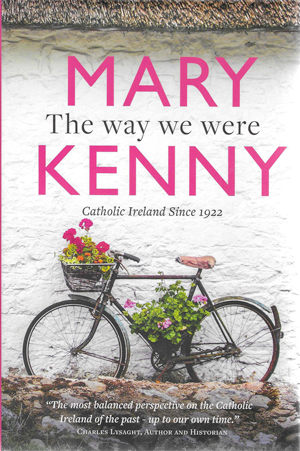MARY KENNY
Columba Books
€19.99
ISBN 9781782183860
Reviewed by Sarah-Anne Buckley

Sarah-Anne Buckley lectures in history at the University of Galway.
Mary Kenny states that the focus of her most recent book, The way we were, is twofold. Part 1 examines ‘the context of history’ and Catholic Ireland since 1922. Part 2 explores the ‘men and women of distinction who were formed by the values of Catholic Ireland’. The blurb states that, ‘when the values of Catholic Ireland are so often viewed in a negative light, Mary Kenny’s approach is a balanced recollection’.
Reviewing this book as a historian was interesting, as Kenny regularly references historical context. She is concerned about presentism and infers that young people do not have enough life experience to ‘tell how it was’ (although I am unsure whether young/er historians are included in this). While this is primarily a memoir or reflection on Catholic Ireland, Kenny includes references to a range of historical texts, and the book will, I’m sure, be viewed by many as a history of Catholic Ireland.
Kenny writes in an engaging way, and her many digressions—primarily used to point out who was married to or related to whom—were for me the most enjoyable aspects of the book. Her writings on her own life and family history, and her thoughts on individuals and characters like Peter Lennon or Ireland’s apparently endless radical priests, were far more interesting than sweeping statements on Irish economic policy or the bizarre number of references to the Irish aviation industry. Kenny has lived a colourful and interesting life. Her road to journalism was certainly not a straight one. She frankly states: ‘having been a giggling waitress and a terrible secretary, I was now in for a period of being a useless au pair’. Her interactions with many in political and artistic circles will be of interest to those who experienced those days, and to have spent 60 years in journalism is no mean feat.
At times, however, the book feels as if you are sitting at a soirée ‘having the larks’, as Kenny regales you with the shocks and gossip. These intermittent discussions of individuals like Nell McCafferty and Charles Haughey are interesting, but none come without a value judgement (Mary Robinson/Professor Robinson and Eavan Boland were ‘the posh girls from the post convent schools’). Often, when women are successful, luck and timing are the reasons given—the election of Mary Robinson and the success of the feminist movement being the chief examples.
Many readers will approach the book to see whether Kenny’s views have changed on the history of second-wave feminism or the Irish Women’s Liberation Movement (IWLM), of which she was a founding member. She certainly downplays the role of the group, arguing that they had good timing and good fun—‘“Women’s Lib” in Ireland took on an aura of pleasing naughtiness and piquant celebrity’. She is somewhat baffled by the attention given to episodes such as the ‘Contraceptive Train’ and gives sparse attention to the work of feminist historians in recent decades.
The broad statements and assessments contained in the book could be viewed as both benign and provocative—‘writers are often loners: journalists are sociable’; ‘Despite my uncle’s concerns about “lawlessness”, Ireland seemed a very safe and secure society—perhaps because of the homogeneity, perhaps because many young men had emigrated, and young males are, indeed, the most likely to be involved in crime’. Yet on the history of the institutions, to which Kenny refers very briefly in early chapters and then more fully in an Epilogue, she views the revelations in recent decades as key to the demise of Catholic Ireland but argues that the abuse was not known to her or to her contemporaries. Even today, she refers to individuals directly affected as ‘orphans’, and later as ‘survivors’, but states that they have been ‘emotionally damaged, and that wound must inflame their perspective on the experience’. In this instance, therefore, personal experience does not meet the standard of context as history set out earlier. To avoid ‘presentism’, Kenny’s language is certainly of its time and there are several references to women who were ‘pregnant out of wedlock’ and discussions of ‘homosexual couples’. There is a sense that perhaps the shock factor is important to Kenny in many of these chapters, or that the progress that ‘liberal Ireland’ has made is not acceptable.
Many readers will, no doubt, recognise the Ireland that Mary Kenny describes, particularly urban Ireland in the 1970s. Others will not recognise it at all. In her treatment of the early years of the state and up to the 1960s, arguably too much is covered and nothing in enough depth. Similarly, the book would have been better served if Part 2 was not as long or if perhaps these profiles had been integrated into a shorter, slimmer book.
While Kenny equates maturing with being more measured, the cynic in me does not agree that that is the premise for this book, and at times her tone can be patronising. The context for this book is clearly Kenny’s own view or views on the past, present and future of Catholic Ireland. It is a defence, and an attack (albeit a humorously delivered one) on recent legislative changes and the increasing secularisation of Irish society. It is a memoir of an Ireland that was, without the warts. For those who work and write on the history of this period, it will remain a recollection or source for reflection—but, as I’m sure Kenny herself would agree, it is one that needs to be viewed in the context in which it was written.
